nixon
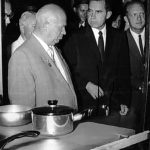 The debate between capitalism and communism is not new, and in fact has been going on for a long time. Possibly one of the strangest debates, known as the “kitchen debate” was between Vice President Nixon and Soviet leader Nikita Khrushchev. The debate was heated at times, but what was strangest about the debate was the fact that it took place in the middle of a model kitchen set up for an exhibit. Why they would have such a discussion in a model kitchen at a national exhibit is the really beyond me, but that is where it took place.
The debate between capitalism and communism is not new, and in fact has been going on for a long time. Possibly one of the strangest debates, known as the “kitchen debate” was between Vice President Nixon and Soviet leader Nikita Khrushchev. The debate was heated at times, but what was strangest about the debate was the fact that it took place in the middle of a model kitchen set up for an exhibit. Why they would have such a discussion in a model kitchen at a national exhibit is the really beyond me, but that is where it took place.
The so-called “kitchen debate” became one of the most famous episodes of the Cold War, and many think it might have really led to fighting words, had it not been for the two men controlling their tempers in the end. The meeting was set up in late 1958. In an effort to draw the two nations closer together, the Soviet Union and the United States agreed to set up national exhibitions in each other’s nation as part of their new emphasis on cultural exchanges. The Soviet exhibition opened in New York City in June 1959, and the United States exhibition opened in Sokolniki Park in Moscow in July. On July 24, before the Moscow exhibit was officially opened to the public, Vice President Nixon served as a host for a visit by Soviet leader Khrushchev. As Nixon led Khrushchev through the American exhibition, the Soviet leader’s famous temper began to flare. When Nixon demonstrated some new American color television sets, Khrushchev launched into an attack on the so-called “Captive Nations Resolution” passed by the United Stares Congress just days before. The resolution condemned the Soviet control of the “captive” peoples of Eastern Europe and asked all Americans to pray for their deliverance. I don’t suppose that resolution set well with Khrushchev, and coming right before the exhibition probably set the whole debate in motion.
After denouncing the resolution, Khrushchev then sneered at the United States technology on display, saying that the Soviet Union would have the same sort of gadgets and appliances within a few years. Nixon, was not a man to back down from a debate, so he cane right back and goaded Khrushchev by stating that the Russian leader should “not be afraid of ideas. After all, you don’t know everything.” The Soviet leader snapped at Nixon, “You don’t know anything about communism–except fear of it.” With a small army of reporters and photographers following them, Nixon and Khrushchev continued their argument in the kitchen of a model home built in the exhibition. With their voices rising and fingers pointing, the two men went at each other. I’m sure it was quite a show. Nixon suggested that Khrushchev’s constant threats of using nuclear missiles could lead to war, and he chided the Soviet for constantly interrupting him while he was speaking. Taking these words as a threat, Khrushchev warned of “very bad consequences.” Perhaps feeling that the exchange had gone too far, the Soviet leader then noted that he simply wanted “peace with all other nations, especially America.” Nixon, 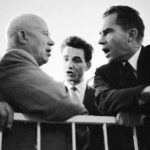 feeling slightly embarrassed said that he had probably not “been a very good host.” The debate, so quickly inflamed, fizzled in much the same way…at least between the two men…not so much the media.
feeling slightly embarrassed said that he had probably not “been a very good host.” The debate, so quickly inflamed, fizzled in much the same way…at least between the two men…not so much the media.
The “kitchen debate” was front-page news in the United States the next day. For a few moments, in the confines of a “modern” kitchen, the diplomatic gloves had come off and America and the Soviet Union had verbally jousted over which system was superior…communism or capitalism. As with so many Cold War battles, however, there was no clear winner…except perhaps for the United States media, which had a field day with the dramatic encounter. It was the sensationalism that the news media craves.
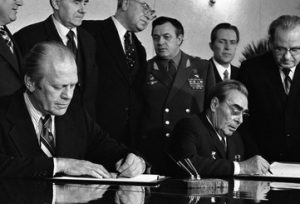 During the Cold War, the threat of a nuclear attack was the biggest concern in world relationships. During the late 1960s, the United States learned that the Soviet Union had embarked upon a massive Intercontinental Ballistic Missile (ICBM) buildup designed to catch up with the United States. The situation seemed to be heating up, because the Soviet Union seemed far more likely to use such weapons, so it looked like it was time to take action. In January 1967, President Lyndon Johnson announced that the Soviet Union had begun to construct a limited Anti-Ballistic Missile (ABM) defense system around Moscow. The development of an ABM system could allow one side to launch a first strike and then prevent the other from retaliating by shooting down incoming missiles. That was completely unacceptable.
During the Cold War, the threat of a nuclear attack was the biggest concern in world relationships. During the late 1960s, the United States learned that the Soviet Union had embarked upon a massive Intercontinental Ballistic Missile (ICBM) buildup designed to catch up with the United States. The situation seemed to be heating up, because the Soviet Union seemed far more likely to use such weapons, so it looked like it was time to take action. In January 1967, President Lyndon Johnson announced that the Soviet Union had begun to construct a limited Anti-Ballistic Missile (ABM) defense system around Moscow. The development of an ABM system could allow one side to launch a first strike and then prevent the other from retaliating by shooting down incoming missiles. That was completely unacceptable.
President Johnson decided to call for strategic arms limitations talks…nicknamed SALT, and in 1967, he and Soviet Premier Alexei Kosygin met at Glassboro State College in New Jersey. Johnson said they must gain “control of the ABM race,” and Secretary of Defense Robert McNamara argued that the more each reacted to the other’s escalation, the more they had chosen “an insane road to follow.” Completely abolishing nuclear weapons would be impossible, but limiting the development of both offensive and defensive strategic systems could be done, and it might help stabilize relations between the 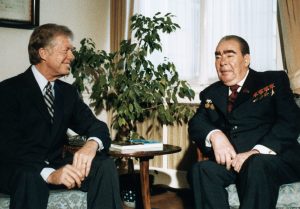 United States and the Soviet Union. The resulting SALT-I treaty was signed in 1972. The 1972 treaty limited a wide variety of nuclear weapons, but it did not address many of the other issues, so shortly after the SALT-I treaty was ratified, talks between the United States and the Soviet Union began anew. Those talks failed to achieve any new breakthroughs. By 1979, both the United States and the Soviet Union were eager to try again. For the United States, the thought that the Soviets were leaping ahead in the arms race was the primary motivator. For the Soviet Union, the increasingly close relationship between America and communist China was a cause for growing concern.
United States and the Soviet Union. The resulting SALT-I treaty was signed in 1972. The 1972 treaty limited a wide variety of nuclear weapons, but it did not address many of the other issues, so shortly after the SALT-I treaty was ratified, talks between the United States and the Soviet Union began anew. Those talks failed to achieve any new breakthroughs. By 1979, both the United States and the Soviet Union were eager to try again. For the United States, the thought that the Soviets were leaping ahead in the arms race was the primary motivator. For the Soviet Union, the increasingly close relationship between America and communist China was a cause for growing concern.
The SALT-II agreement was the result of those many nagging issues that were left over from the successful SALT-I treaty of 1972, but it had problems of its own. The treaty basically established numerical equality between the two nations in terms of nuclear weapons delivery systems. It also limited the number of MIRV missiles (missiles with multiple, independent nuclear warheads). In truth, the treaty did little or nothing to stop, or even substantially slow down, the arms race, and it met with unrelenting criticism in the United States. The treaty was thought to be a “sellout” to the Soviets. People believed that it would leave America virtually defenseless against a whole range of new weapons not mentioned in the agreement. Even supporters of arms control were less than enthusiastic about the treaty, since it did little to actually control arms. Nevertheless, during a summit meeting in Vienna, President Jimmy Carter and Soviet leader Leonid Brezhnev signed the 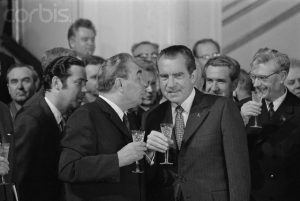 SALT-II agreement dealing with limitations and guidelines for nuclear weapons, on June 18, 1979. The treaty, would never formally go into effect, and it proved to be one of the most controversial agreements between the United States and the Soviet Union of the entire Cold War. Debate over SALT-II in the U.S. Congress continued for months. Then in December 1979, the Soviets invaded Afghanistan. The Soviet attack effectively killed any chance of SALT-II being passed, and Carter ensured this by withdrawing the treaty from the Senate in January 1980. SALT-II thus remained signed, but was never ratified. During the 1980s, both nations agreed to respect the agreement until such time as new arms negotiations could take place.
SALT-II agreement dealing with limitations and guidelines for nuclear weapons, on June 18, 1979. The treaty, would never formally go into effect, and it proved to be one of the most controversial agreements between the United States and the Soviet Union of the entire Cold War. Debate over SALT-II in the U.S. Congress continued for months. Then in December 1979, the Soviets invaded Afghanistan. The Soviet attack effectively killed any chance of SALT-II being passed, and Carter ensured this by withdrawing the treaty from the Senate in January 1980. SALT-II thus remained signed, but was never ratified. During the 1980s, both nations agreed to respect the agreement until such time as new arms negotiations could take place.
 From November 1, 1955 until April 30, 1975, the Vietnam war raged. The United States entered the war on March 8, 1965. It was an unpopular war from the start. Those who protested US involvement felt like it wasn’t our war and we shouldn’t be there. Be that as it may, we were there, and for the time being, we weren’t going anywhere. The war was a long one, but on April 30, 1975, it came to an abrupt end, when Saigon fell.
From November 1, 1955 until April 30, 1975, the Vietnam war raged. The United States entered the war on March 8, 1965. It was an unpopular war from the start. Those who protested US involvement felt like it wasn’t our war and we shouldn’t be there. Be that as it may, we were there, and for the time being, we weren’t going anywhere. The war was a long one, but on April 30, 1975, it came to an abrupt end, when Saigon fell.
At dawn that spring morning, communist forces moved into Saigon, where they received only sporadic resistance. The South Vietnamese forces had collapsed under the rapid advancement of the North Vietnamese. The most recent fighting had begun in December 1974. That was when the North Vietnamese launched a major attack against the lightly defended province of Phuoc Long, which was located due north of Saigon along the Cambodian border, overrunning the provincial capital at Phuoc Binh on January 6, 1975. Despite previous promises, from President Nixon, to provide aid if the communists attacked Saigon, the United States did nothing. The problem…Nixon had resigned from office and his successor, Gerald Ford, was unable to convince a hostile Congress to keep Nixon’s earlier promises to rescue Saigon from communist takeover. The United States had its own set of tumultuous circumstances to deal with at that time.
The lack of response from the United States emboldened the North Vietnamese, who launched a new campaign 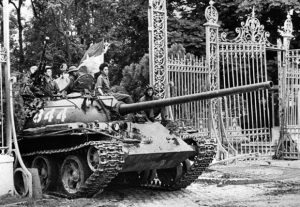 in March 1975. The South Vietnamese forces fell back in total chaos, and once again, the United States did nothing. The South Vietnamese abandoned Pleiku and Kontum in the Highlands with little to no fighting. Then Quang Tri, Hue, and Da Nang fell to the communist onslaught. The North Vietnamese continued to attack south along the coast toward Saigon, defeating the South Vietnamese forces at each encounter.
in March 1975. The South Vietnamese forces fell back in total chaos, and once again, the United States did nothing. The South Vietnamese abandoned Pleiku and Kontum in the Highlands with little to no fighting. Then Quang Tri, Hue, and Da Nang fell to the communist onslaught. The North Vietnamese continued to attack south along the coast toward Saigon, defeating the South Vietnamese forces at each encounter.
The South Vietnamese 18th Division had fought a valiant battle at Xuan Loc, just to the east of Saigon, destroying three North Vietnamese divisions in the process. They were the only division that seemed capable of continuing the fight. That was to be the last battle in the defense of the Republic of South Vietnam. The South Vietnamese forces held out against the attackers until they ran out of tactical air support and weapons, finally abandoning Xuan Loc to the communists on April 21, 1975.
Having crushed the last major organized opposition before Saigon, the North Vietnamese got into position for the final assault. In Saigon, South Vietnamese President Nguyen Van Thieu resigned and transferred authority to Vice President Tran Van Huong before fleeing the city on April 25. By April 27, the North Vietnamese had  completely encircled Saigon and began to maneuver for a complete takeover. When they attacked at dawn on April 30, they met little resistance. North Vietnamese tanks crashed through the gates of the Presidential Palace and the war came to an end. North Vietnamese Colonel Bui Tin accepted the surrender from General Duong Van Minh, who had taken over after Tran Van Huong and had only spent only one day in power. Tin explained to Minh, “You have nothing to fear. Between Vietnamese there are no victors and no vanquished. Only the Americans have been beaten. If you are patriots, consider this a moment of joy. The war for our country is over.” Of course, this also meant that Vietnam would be a Communist country, like it or not.
completely encircled Saigon and began to maneuver for a complete takeover. When they attacked at dawn on April 30, they met little resistance. North Vietnamese tanks crashed through the gates of the Presidential Palace and the war came to an end. North Vietnamese Colonel Bui Tin accepted the surrender from General Duong Van Minh, who had taken over after Tran Van Huong and had only spent only one day in power. Tin explained to Minh, “You have nothing to fear. Between Vietnamese there are no victors and no vanquished. Only the Americans have been beaten. If you are patriots, consider this a moment of joy. The war for our country is over.” Of course, this also meant that Vietnam would be a Communist country, like it or not.

